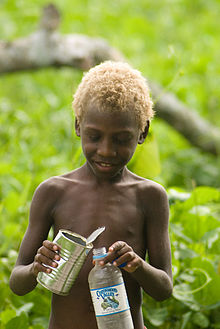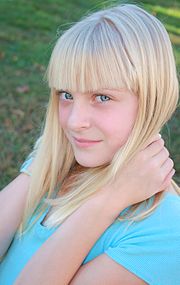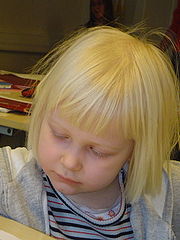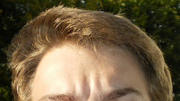- Blond
-
"Blond" and "blonde" redirect here. For other uses, see Blond (disambiguation) and blonde (disambiguation).
Blond or blonde (see below) or fair-hair is a hair color characterized by low levels of the dark pigment eumelanin. The resultant visible hue depends on various factors, but always has some sort of yellowish color. The color can be from the very pale blond (caused by a patchy, scarce distribution of pigment) to reddish "strawberry" blond colors or golden-brownish ("sandy") blond colors (the latter with more eumelanin). On the Fischer–Saller scale blond color ranges from A to J (blond brown).[1]
Contents
Etymology, spelling, and grammar
The word "blond" is first attested in English in 1481 and derives from Old French blund, blont meaning "a colour midway between golden and light chestnut". It gradually eclipses the native term "fair", of same meaning, from Old English fæġer, to become the general term for "light complexioned". The French (and thus also the English) word "blond" has two possible origins. Some linguists say it comes from Medieval Latin blundus, meaning "yellow", from Old Frankish *blund which would relate it to Old English blonden-feax meaning "grey-haired", from blondan/blandan meaning "to mix" (Cf. blend). Also, Old English beblonden meant "dyed" as ancient Germanic warriors were noted for dying their hair.
However, other linguists[who?] who favor a Latin origin for the word say that Medieval Latin blundus was a vulgar pronunciation of Latin flavus, also meaning yellow. Most authorities, especially French, attest the Frankish origin. The word was reintroduced into English in the 17th century from French, and was for some time considered French; in French, "blonde" is a feminine adjective; it describes a woman with blond hair.[2]
"Blond" and "blonde", with its continued gender-varied usage, is one of few adjectives in written English to retain separate masculine and feminine grammatical genders. Each of the two forms, however, is pronounced the same way. American Heritage's Book of English Usage propounds that, insofar as "a blonde" can be used to describe a woman but not a man who is merely said to possess blond(e) hair, the term is an example of a "sexist stereotype [whereby] women are primarily defined by their physical characteristics."[3] The Oxford English Dictionary records that the phrase "big blond beast" was used in the 20th century to refer specifically to men "of the Nordic type" (that is to say, blond-haired). Particularly this had associations with Friedrich Nietzsche's Übermensch.[4] The OED also records that blond as an adjective is especially used with reference to women, in which case it is likely to be spelt "blonde", citing three Victorian usages of the term. The masculine version is used to describe a plural, in "blonds of the European race",[4] in a citation from 1833 Penny cyclopedia, which distinguishes genuine blondness as a Caucasian feature distinct from albinism.[5] By the early 1990s, "blonde moment" or being a "dumb blonde" had come into common parlance to mean "an instance of a person, esp. a woman... being foolish or scatter-brained."[6] Another hair color word of French origin, brunet(te), also functions in the same way in orthodox English. The OED gives "brunet" as meaning "dark-complexioned" or a "dark-complexioned person", citing a comparative usage of brunet and blond to Thomas Henry Huxley in saying, "The present contrast of blonds and brunets existed among them".[7] "Brunette" can be used, however, like "blonde", to describe a mixed-gender populace. The OED quotes Grant Allen, "The nation which resulted..being sometimes blonde, sometimes brunette."[8]
"Blond" and "blonde" are also occasionally used to refer to objects that have a color reminiscent of fair hair. Examples include pale wood and lager beer. For example, the OED records its use in 19th century poetic diction to describe flowers, "a variety of clay ironstone of the coal measures", "the colour of raw silk",[4] and a breed of ray.[9]
Varieties
Many sub-categories of blond hair have also been defined to describe someone with blond hair more accurately. Common examples include the following:
- blond/flaxen[10][11] – when distinguished from other varieties, "blond" by itself refers to a light but not whitish blond with no traces of red, gold, or brown. This color is often described as "flaxen".
- yellow – yellow-blond ("yellow" can also be used to refer to hair which has been dyed yellow).
- platinum blond[12] or towheaded[13][14] – whitish-blond; almost all platinum blonds are children. "Platinum blond" is often used to describe bleached hair, while "towheaded" generally refers to natural hair color.
- sandy blond[15][16] – greyish-hazel or cream-colored blond.
- golden blond – a darker to rich, golden-yellow blond.
- strawberry blond,[17] Venetian blond or honey blond – a light or dark reddish golden blond.
- dirty blond[18] or dishwater blond[19] – dark blond with flecks of golden blond and brown.
- ash-blond[20] – pale or grayish blond.
- bleached blond, bottle blond, or peroxide blond[21] – artificial blond slightly less white than platinum blond.
Evolution of blond hair
Natural lighter hair colors occur most often in Europe and less frequently in other areas.[22] In northern European populations, the occurrence of blond hair is very frequent. The hair color gene MC1R has at least seven variants in Europe giving the continent a wide range of hair and eye shades. Based on recent genetic research carried out at three Japanese universities, the date of the genetic mutation that resulted in blond hair in Europe has been isolated to about 11,000 years ago during the last ice age.[23]
A typical explanation found in the scientific literature for the evolution of light hair is related to the requirement for vitamin D synthesis and northern Europe's seasonal deficiency of sunlight.[24] Lighter skin is due to a low concentration in pigmentation, thus allowing more sunlight to trigger the production of vitamin D. In this way, high frequencies of light hair in northern latitudes are a result of the light skin adaptation to lower levels of sunlight, which reduces the prevalence of rickets caused by vitamin D deficiency. The darker pigmentation at higher latitudes in certain ethnic groups such as the Inuit is explained by a greater proportion of seafood in their diet. As seafood is high in vitamin D, vitamin D deficiency would not create a selective pressure for lighter pigmentation in that population.
An alternative hypothesis was presented by Canadian anthropologist Peter Frost, under the aegis of University of St Andrews, who published a study in March 2006 in the journal Evolution and Human Behavior. Frost said blond hair evolved very quickly in a specific area at the end of the last ice age by means of sexual selection.[25] According to the study, the appearance of blond hair and blue eyes in some northern European women made them stand out from their rivals at a time of fierce competition for scarce males. The study argues that blond hair was produced higher in the Cro-Magnon descended population of the European region because of food shortages 10,000-11,000 years ago following the last glacial period when most of it was covered by steppe-tundra. Almost the only sustenance in northern Europe came from roaming herds of mammoths, reindeer, bison and horses and finding them required long, arduous hunting trips in which numerous males died, leading to a high ratio of surviving women to men. This hypothesis argues that women with blond hair posed an alternative that helped them mate and thus increased the number of blonds.[26]
A theory propounded in The History and Geography of Human Genes (1994), says blond hair became predominant in Northern Europe beginning about 3,000 BC, in the area now known as Lithuania, among the recently arrived Proto-Indo-European settlers (according to the Kurgan hypothesis), and the trait spread quickly through sexual selection into Scandinavia. As above, the theory assumes that men found women with blond hair more attractive.[27]
Geographic distribution
Blond hair is most frequently found among the populations of Northern Europe. The pigmentation of both hair and eyes is lightest around the Baltic Sea and their darkness increases regularly and almost concentrically around this region.[28] A 2009 study found that light hair colors were already present in southern Siberia during the Bronze Age.[29] Due to migration from Europe from the 16th to the 20th centuries, blonds are also found all around the world such as in North America, South America, Australia, New Zealand, South Africa etc.
 A boy with blond hair in Vanuatu
A boy with blond hair in Vanuatu
Generally, blond hair in Europeans is associated with lighter eye color (gray, blue, green and hazel) and light (sometimes freckled) skin tone. Strong sunlight also, on some people but not all, lightens hair of any pigmentation,[citation needed] to varying degrees, and causes many blond people to freckle, especially during childhood.
In Central Asia, the Middle East and South Asia, there is also a low frequency of natural blonds found among some ethnic populations. In Pakistan, the Kalash tribe mostly have blond hair. In Afghanistan, blonds are particularly found among the Tajik (10% blond, especially in the Pamir region),[30] Nuristani people (related to the Kalash) who have a blond hair frequency of one in three.[31] Blonde hair color can naturally occur even among other people from the Khyber Pakhtunkhwa and Gilgit-Baltistan of Pakistan; this group includes Khowar people, Pashtuns, Kashmiris, Shina people, Burusho, and descendants of European colonists (the latter found in Goa, Pondicherry).[citation needed]
Blonds are also found in Turkey, especially in the northern (Caucasus) and western (European) parts of the country. Blonds are also found in parts of southwest and northern Iran, especially in the Caspian and Caucasus provinces. Blonds are also found in the Levant, Israel (especially among the Ashkenazi), in western Syria, in northern Iraq, and in the Palestinian territories. Jordan and Lebanon have a frequency of blonds as well. Blond hair is also a common sight among Berbers of North Africa, especially in the Rif and Kabyle region and also among Maghreb Arabs of Berber descent.[32]
Aboriginal Australians, especially in the west-central parts of the continent, have a high frequency of natural blond-to-brown hair,[33] with as many as 90–100% of children having blond hair in some areas.[34] The trait among Indigenous Australians is primarily associated with children. In maturity the hair usually turns a darker brown color, but sometimes remains blond.[34] Blondness is also found in some other parts of the South Pacific, such as the Solomon Islands, Vanuatu, and Fiji, again with higher incidences in children. Blondness was also reported among indigenous peoples in South America known as Cloud People[35] or Chachapoyas. There can be blond hair among Peruvian mestizos of mixed Cloud People and Spanish and/or other European descent.
Relation to age
Blond hair is most common in Caucasian infants and children,[36] so much so that the term "baby blond" is often used for very light colored hair. Babies may be born with blond hair even among groups where adults rarely have blond hair although such natural hair usually falls out quickly. Blond hair tends to turn darker with age, and many children's blond hair turns light, medium, dark brown or black before or during their adult years.[36]
Folklore and mythology
Southern Europe
The Greek gods are attested varying in their appearances. While Poseidon was described as having a blue-black beard, and Zeus blue-black eyebrows, Pindar described Athena as fair-haired, and Pheidas described her as golden-haired. Hera, Apollo and Aphrodite were also described as blonds.[37] Pindar collectively described the Homeric Danaans of the time of the war between Argos and Thebes as fair-haired.[37] The Spartans are described as fair-haired by Bacchylides. In the work of Homer, Menelaus the king of the Spartans is, together with other Achaean leaders, portrayed as blond.[37] Although dark hair colours were predominant in the works of Homer, there is only one case of a dark hero, and that is when the blond Odysseus is transformed by Athena and his beard becomes blue-black. Other blond characters in Homer are Peleus, Achilles, Meleager, Agamede, and Rhadamanthys.[37]
 Details of the "bikini girls" mosaic at Villa Romana del Casale, Sicily, 4th century AD.
Details of the "bikini girls" mosaic at Villa Romana del Casale, Sicily, 4th century AD.
According to Francis Owens[38] Roman literary records describe a very large number of well-known Roman historical personalities as blond. In addition, 250 individuals are recorded to have had the name Flavius, meaning blond, and there are many named Rufus and Rutilius, meaning red haired and reddish-haired, respectively. The following Roman gods are said to have had blond hair: Amor, Apollo, Aurora, Bacchus, Ceres, Diana, Jupiter, Mars, Mercury, Minerva and Venus.[38] For example, the physical appearance of Emperor Nero, descended from an aristocratic family, is by the historian Suetonius described as: "... his hair light blond,... his eyes blue..."[39]
According to Victoria Sherrow, Romans preferred to dye their hair dark in the early period of Ancient Rome; at one point in time blond hair was even associated with prostitutes.[40] The preference changed to bleaching the hair blond when Greek culture, which practiced bleaching, reached Rome, and was reinforced when the legions that conquered Gaul returned with blond slaves.[40]
Northern Europe
In Norse mythology, the goddess Sif has famously blonde hair, which some scholars have identified as representing golden wheat.[41] In the Poetic Edda poem Rígsþula, the blond man Jarl is considered to be the ancestor of the dominant warrior class.
In Northern European folklore, supernatural beings value blonde hair in humans. Blonde babies are more likely to be stolen and replaced with changelings, and young blonde women are more likely to be lured away to the land of the beings.[42] Elves and fairies were often portrayed with blond hair in illustrations in children's book of fairy tales. This continues the theme that blond hair is associated with beauty and goodness.
Fiction
In Miguel de Cervantes' Don Quixote, the ideal beauty is Dulcinea whose "hairs are gold"; in Milton's poem Paradise Lost the noble and innocent Adam and Eve have "golden tresses",[43][44] the protagonist-womanizer in Guy de Maupassant's novel Bel Ami who "recalled the hero of the popular romances" has "slightly reddish chestnut blond hair", while near the end of J. R. R. Tolkien's work The Lord of the Rings, the especially favorable year following the War of the Ring was signified in the Shire by an exceptional number of blonde-haired children.
Contemporary popular culture
In contemporary popular culture, it is often stereotyped that men find blonde women more attractive than women with other hair colors.[40] For example, Anita Loos popularized this idea in her 1925 novel Gentlemen Prefer Blondes.[40] Blondes are often assumed to have more fun, for example in a Clairol commercial for hair colorant they use the phrase "Is it true blondes have more fun?"[40] Some women have reported after lightening their hair they feel other people expect them to be more fun-loving.[40] The "blonde stereotype" is also associated with being less serious or less intelligent.[40] This can be seen in blonde jokes.[40] It is believed the originator of the "dumb blonde" was an 18th century blonde French prostitute named Rosalie Duthe whose reputation of being beautiful but dumb inspired a play about her called Les Curiosites de la Foire (Paris 1775).[40] Blonde actresses have supported this role; some of them include Marilyn Monroe, Judy Holliday, Jayne Mansfield, and Goldie Hawn during her time at Laugh-In.[40] Alfred Hitchcock preferred to cast blonde women for major roles in his films as he believed that the audience would suspect them the least, comparing them to "virgin snow that shows up the bloody footprints", hence the term "Hitchcock blonde".[45] This stereotype has become so ingrained it has spawned counter-narratives, such as in the 2001 film Legally Blonde in which Reese Witherspoon succeeds at Harvard despite biases against her beauty and blonde hair,[40] and terms developed such as cookie cutter blond (CCB), implying standardized blond looks and standard perceived social and intelligence characteristics of a blond. Many actors and actresses in Mestizo America and Hispanic United States seem to have Nordic features—blond hair, blue eyes, and pale skin[46][47][48][49][50][51][52][53]
In science fiction, nordic aliens are described as human-looking with blond hair and blue eyes, hence the name 'nordic'. They are benign, following the association of blond hair with beauty and goodness in European folklore and mythology.
See also
References
- ^ "Analysis of Hair Samples of Mummies from Semna South (Sudanese Nubia)". American Journal of Physical Anthropology. 1978. http://wysinger.homestead.com/hair_semma.pdf. Retrieved 2011-02-03.
- ^ Origin of "blonde", from Online Etymology Dictionary.
- ^ "Blonde/Brunet" from The American Heritage Dictionary of the English Language (1996)
- ^ a b c "blonde, blond, a. and n." The Oxford English Dictionary. 2nd ed. 1989. OED Online. Oxford University Press. 5 Aug. 2010 <http://dictionary.oed.com/cgi/entry/50023771>.
- ^ Penny cyclopaedia of the Society for the Diffusion of Useful Knowledge, s.v. Albinos. Society for the Diffusion of Useful Knowledge (Great Britain, 1833).
- ^ "blonde, blond, a. and n." The Oxford English Dictionary. June 2006 [draft editions]. OED Online. Oxford University Press. 5 Aug. 2010 <http://dictionary.oed.com/cgi/entry/50023771>.
- ^ "brunet, a. and n." The Oxford English Dictionary. June 2006 [draft editions]. OED Online. Oxford University Press. 5 Aug. 2010 <http://dictionary.oed.com/cgi/entry/50028357>.
- ^ "brunette, n. and a." The Oxford English Dictionary. June 2006 [draft editions]. OED Online. Oxford University Press. 5 Aug. 2010 <http://dictionary.oed.com/cgi/entry/50028359>.
- ^ "blonde, blond, a. and n." The Oxford English Dictionary. Additions Series 1997. OED Online. Oxford University Press. 5 Aug. 2010 <http://dictionary.oed.com/cgi/entry/50023771>.
- ^ "Flaxen" in the American Heritage Dictionary
- ^ "Flaxen" in Merriam-Webster
- ^ "Platinum blonde" in Merriam-Webster
- ^ "Towhead" in the American Heritage Dictionary
- ^ "Towhead" in Merriam-Webster
- ^ "Sandy" in the American Heritage Dictionary
- ^ "Sandy" in Merriam-Webster
- ^ "Strawberry blond" in the American Heritage Dictionary
- ^ "Dirty blond" at Dictionary.com
- ^ ""Dishwater blonde" in Encarta". "Dishwater blonde" in Encarta. http://encarta.msn.com/encnet/features/dictionary/DictionaryResults.aspx?refid=1861689142.
- ^ "Ash-blond" in Merriam-Webster
- ^ "Peroxide blond" at Dictionary.com
- ^ "Cavegirls were first blondes to have fun", from The Times. Note, the end of the Times article reiterates the disappearing blonde gene hoax; the online version replaced it with a rebuttal.
- ^ Dobson, Roger; Taher, Abul (2006-02-26). "CorrectedCavegirls were first blondes to have fun". The Times (London). http://www.timesonline.co.uk/tol/news/uk/article735078.ece. Retrieved 2010-04-26.
- ^ Robins, Ashley H. Biological perspectives on human pigmentation. Cambridge University Press, 1991, pp. 195–208.
- ^ Abstract: "European hair and eye colour: A case of frequency-dependent sexual selection?" from Evolution and Human Behavior, Volume 27, Issue 2, Pages 85-103 (March 2006)
- ^ Clout, Laura (2007-11-19). "Blonde women make men less clever". The Daily Telegraph (London). http://www.telegraph.co.uk/earth/main.jhtml?xml=/earth/2007/11/19/sciblonde119.xml. Retrieved 2010-04-26.
- ^ Cavalli-Sforza, Luigi Luca; Menozzi, Paolo; Piazza, Alberto (1994). "Europe". The History and Geography of Human Genes. Princeton, New Jersey: Princeton University Press. p. 266. ISBN 978-0-691-08750-4.
- ^ Cavalli-Sforza, L., Menozzi, P. and Piazza, A. (1994) The History and Geography of Human Genes. Princeton: Princeton University Press.
- ^ Christine Keyser, Caroline Bouakaze, Eric Crubézy, Valery G. Nikolaev, Daniel Montagnon, Tatiana Reis and Bertrand Ludes (2009). Ancient DNA provides new insights into the history of south Siberian Kurgan people. Human Genetics. Volume 126, Number 3, 395-410, DOI: 10.1007/s00439-009-0683-0.
- ^ "Around the Roof of the World". Nicholas Shoumatoff, Nina Shoumatoff (2000). University of Michigan Press. p.9. ISBN 0-472-08669-3
- ^ Dupree, L.. "Afghānistān: (iv.) ethnography". In Ehsan Yarshater. Encyclopædia Iranica (Online Edition ed.). United States: Columbia University. http://www.iranicaonline.org/articles/afghanistan-iv-ethnography. Retrieved 5 November 2011.
- ^ "On the whole, blondism is strong in the Rif; over half of the adult men show some trace of it. But the Rif is not a blond country in the sense that Norway, Sweden, Finland, or even England are blond; it is, however, blonder than most of Spain or southern Italy.", Carleton S. Coon, The Races of Europe (1939), Greenwood Press, 1972, p.482
- ^ "Modern Human Variation: Overview". Anthro.palomar.edu. 2009-11-08. http://anthro.palomar.edu/vary/vary_1.htm. Retrieved 2009-12-20.
- ^ a b "Gene Expression: Blonde Australian Aboriginals". Gnxp.com. http://www.gnxp.com/blog/2005/08/blonde-australian-aboriginals.php. Retrieved 2009-12-20.
- ^ Cloud People Of Peru Ancient city discovered deep in Amazonian rainforest linked to the legendary blond haired white-skinned civilisation of South America.
- ^ a b Ridley, Matt. Red Queen: Sex and the Evolution of Human Nature. Published by HarperCollins, 2nd ed. 2003, pp. 293–294.
- ^ a b c d Myres, John Linton (1967). Who were the Greeks?, pp. 192-199. University of California Press.
- ^ a b " (Francis Owen,The Germanic people; their Origin Expansion & Culture", 1993 Barnes & Noble Books ISBN 0-88029-579-1, page 49.)
- ^ "Suetonius • Life of Nero". Penelope.uchicago.edu. http://penelope.uchicago.edu/Thayer/E/Roman/Texts/Suetonius/12Caesars/Nero*.html#51. Retrieved 2008-12-22.
- ^ a b c d e f g h i j k Victoria Sherrow. Encyclopedia of hair: a cultural history. Page 149
- ^ Ellis Davidson, H. R. (1965). Gods And Myths Of Northern Europe, page 84. Penguin. ISBN 0140136274
- ^ Katharine Briggs, An Encyclopedia of Fairies, Hobgoblins, Brownies, Boogies, and Other Supernatural Creatures, "Golden Hair," p194. ISBN 0-394-73467-X
- ^ Milton, John (1674). Paradise Lost: A Poem in Twelve Books. http://books.google.com/books?id=kbO9UPxIyVAC&pg=PR40&lpg=PR40&dq=in+paradise+lost+is+adam+blonde#PPA93,M1. Retrieved 2008-02-02.
- ^ Milton, John (1674). "Book IV". Paradise Lost. "Her unadorned golden tresses wore"
- ^ Allen, Richard (2007). Hitchcock's Romantic Irony. Columbia University Press. ISBN 978-0-231-13574-0.
- ^ Quinonez, Ernesto (2003-06-19). "Y Tu Black Mama Tambien". http://www.newsweek.com/id/58525?tid=relatedcl. Retrieved 2008-05-02.
- ^ The Blond, Blue-Eyed Face of Spanish TV
- ^ Blonde, Blue-Eyed Euro-Cute Latinos on Spanish TV
- ^ What are Telenovelas? – Hispanic Culture
- ^ Racial Bias Charged On Spanish-Language TV
- ^ Black Electorate
- ^ Jones, Vanessa E. (2004-08-19). "Pride or Prejudice?". Boston.com. http://www.boston.com/news/globe/living/articles/2004/08/19/pride_or_prejudice/?page=2. Retrieved 09-08-2010.
- ^ POV - Corpus Film Description
Human hair color Hair color Hair coloring Blue rinse · Grecian Formula · Hair dye stripping · Hair highlighting · Henna · Hydrogen peroxide · Indian gooseberry · Juglans nigra · Senna · Blue hairOther Categories:- Hair color
- Blond hair
Wikimedia Foundation. 2010.







